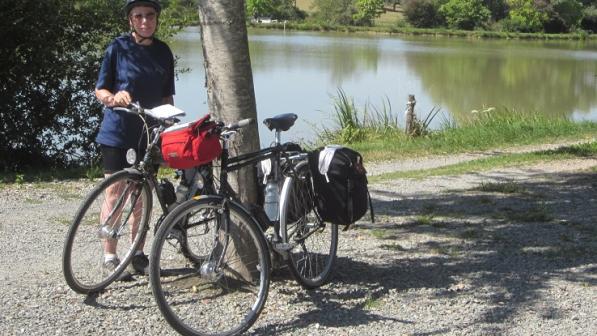Campaign win: Key walking and cycling bridge saved from demolition

The Rhubarb Bridge provides a safe route for people cycling and walking over the A47/A15 junction, but Peterborough council earmarked the bridge for demolition, insisting that it was nearing the end of its life and that to replace it would cost up to £30 million. Local cyclists were concerned there would be no safe way to cross the junction, so they formed the Save Rhubarb Bridge campaign and contacted Cycling UK's campaigns team for support and advice.
£5.5m had been allocated from the council’s local transport plan to demolish the bridge, widen the carriageway and add a series of level crossings. £1m of that funding will now be used to fund structural repairs to the bridge. The level crossings and road widening will go ahead as planned.
The repairs are expected to keep the bridge functional for a further ten years, in which time it is hoped that the council will raise enough money to replace the bridge.
Commenting on the decision, Cllr Peter Hiller, cabinet member for growth, planning, housing and economic development at Peterborough Council, said: “We always wanted to investigate whether the bridge had to be demolished, or whether the integrity of the structure was of a quality that it could be retained.
“It’s a very complex bridge and we were concerned at the time it was approaching the end of its safe life.That has proved not to be the case.”
The decision follows a long battle between the council and concerned local residents, who say that replacing the bridge with a series of level crossings would be extremely dangerous for the many people who currently walk or cycle across the bridge each day.
This is a good win, we have bought ourselves ten years.
Trevor McSparron, founder of Save Rhubarb Bridge
“This is a good win, we have bought ourselves ten years,” says Trevor McSparron, a local resident who initiated the Save Rhubarb Bridge campaign. “I am worried that the road widening and level crossings will prove to be dangerous but with the bridge still in place, travellers will at least have the safe option available to them.”
To make their case the group filmed driver behaviour around the junction. They recorded incidents of people running red lights and talking on their phones while at the wheel. A count of people using the bridge revealed that 2000 people walk or cycle across it each day – including 200 schoolchildren.
The videos that the group filmed and the research they did helped galvanise support for their campaign on social media. Their widespread support added extra strength to the group’s lobbying efforts. A successful petition calling for a council meeting on the matter was what eventually led to the council’s U-turn.
Nyree Ambarchian, Trevor’s partner and fellow campaigner, said “We are cautiously optimistic… we continue to be confused as to why the pedestrian crossings are needed at this stage and remain worried that this is all part of a longer term plan to remove the bridge later on.”
Cycling UK Infrastructure Campaigns Officer Tom Guha said “While the campaign is not over, this victory demonstrates how a small group of concerned residents can save a vital piece of infrastructure and allow thousands of people to continue to walk and cycle each day.”
“With clever use of video and social media and the initiative to seek out assistance from national organisations like Cycling UK, this group successfully overturned a council decision that was clearly wrong and potentially dangerous.
“It was a privilege working with these determined campaigners. I look forward to continuing to support them to ensure that Rhubarb Bridge is here to stay.”



